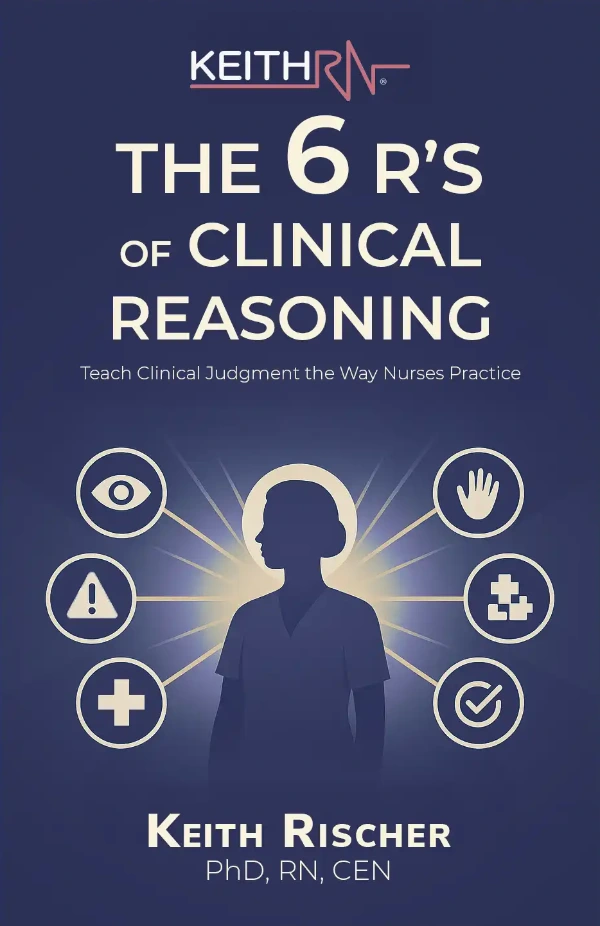
Well known and respected nurse educator Linda Caputi remarked at a recent conference that there is little evidence to support much of what is done in nursing education.
Though the traditional nursing care plan has been a staple in nursing education for decades, is there conclusive evidence that the use of this approach effectively teaches novice students to think more like a nurse?
I believe that it is an academic exercise that obsesses over the correct wording of a 3 part NANDA-I diagnostic statement, but does not practically capture the essence of how a nurse thinks in practice.
There is a better way!
Emphasizing clinical reasoning and integrating this nurse thinking skill will strengthen student learning as well as bring needed transformation to nursing education (Benner, Sutphen, Leonard, & Day, 2010).
Trouble in Paradise
When I started nursing school in 1981, NANDA nursing diagnostic statements were created as a language of the nursing profession. I remember how awkward it was to apply nursing diagnosis as a nursing priority and then write a “correct” three-part statement for my traditional written care plan.
After graduation, I quickly realized that nurses do not think in three-part NANDA statements and began to develop other ways of thinking like a nurse that included the ability to THINK in ACTION and capture the essence of the problem which are principles of clinical reasoning.
Imagine my horror when I re-entered nursing education twenty-five years later as a new nurse educator and found that NANDA-I was still emphasized and was the ONLY way that students were allowed to identify the nursing priority!
I was torn.
How could I support my students who were repeating the same struggles I had as a student twenty-five years earlier?
It was painful and hard to watch this clinical drama unfold every week as clinical students took their NANDA summary card of all 205 nursing diagnostic statements and reviewed it over and over to find a statement that would “fit” their patient for their written care plan.
But in order to be willing to rethink the traditional written care plan, I would like to share some observations that first need to be considered:
1. Nurse Thinking More Complex than Nursing Process
Nursing process is one of the very first things taught in nursing education so students can begin to develop needed nurse thinking to safely care for patients. Nursing process as it is currently taught in nursing education and by fundamental textbooks (Berman & Snyder, 2012) consists of the following five steps:
- Assessing
- Diagnosing
- Planning
- Implementing
- Evaluating
The use of the word “diagnosis” or “diagnosing” in step two of how nursing process is typically taught infers that only a NANDA-I nursing diagnostic statement can be used to identify the nursing priority. This is simply not born out in real-world clinical practice.
As a practicing nurse and nurse educator, I believe that NANDA-I remains relevant but should be seen as a beginning or fundamental level of nurse thinking.
Fundamental content always remains relevant to the practicing nurse with advanced skills built upon this foundation in the second level of nursing education.
In the same way, once NANDA-I and nursing process are taught in fundamentals, PRIORITY setting (with or without NANDA-I) and thinking like a nurse using all aspects of clinical reasoning must be incorporated in the second level of nursing education to successfully transition students to real-world professional practice.
See past blog Transform Nursing Education with a Can of NANDA-Lite!
Multiple Ways of Thinking Needed
Multiple ways of nurse thinking need to be incorporated into nursing education (Benner, Sutphen, Leonard, & Day, 2010).
As a nurse in practice, I see at least three distinct aspects of nurse thinking in addition to nursing process that students must be taught:
- Critical thinking. The ability to USE and APPLY knowledge.
- Pattern recognition or the ability to identify relationships of clinical data to one another
- Clinical reasoning. The ability of the nurse to think in action, reason as a situation changes, identify what clinical data is relevant, and grasp the essence of what is needed to advance the plan of care (Benner, Sutphen, Leonard, & Day, 2010).
2. Three part NANDA-I Nursing Diagnostic Statements is NOT How a Nurse Thinks in Practice
Once the systematic and continuous collection of clinical assessment data is done by the nurse in step 1 of nursing proces, this data must be analyzed and clustered to determine what is most relevant and formulate the best and correct nursing diagnosis.
Step 2 of nursing process requires the student to formulate the correct nursing diagnosis using one of the 205 NANDA statements and then complete with a three-part nursing diagnostic statement that includes the following key components:
- NANDA statement
- Related to…
- Manifested by…
There is only one problem with this traditional approach: this is NOT how a nurse in clinical practice thinks and establishes nursing care priorities, especially when there is a change of status.
As you reflect on your experience as a nurse who practiced at the bedside, did you think and set care priorities using only NANDA-I statements and then formulate a three-part statement?
Other clinical concerns related to the exclusive use of NANDA-I in care plans is that there are numerous NANDA-I statements that do not capture the ESSENCE of the current patient priority.
Why NANDA Can Be a NONO
The inability of NANDA-I to capture the essence of a change in status, translates to failure to rescue when a change in patient status occurs (del Bueno, 2005).
del Bueno (2005) found that new nurses were unable to exercise correct clinical judgment at a basic level to “rescue” (identify the problem and then intervene) their patient in a simulated scenario due to inappropriate use of NANDA nursing diagnostic statements to make them “fit” when there was a change in status (del Bueno, 2005).
For example, when a patient had a condition change consistent with a stroke, the nurse used the NANDA statement “alteration in sensory perception” or “alteration in nutrition.” In another patient having symptoms consistent with a myocardial infarction, the nurse used “activity intolerance related to pain” (del Bueno, 2005). For more, see past blog Why NANDA is a NONO.
3. Clinical Reasoning is the Essence of Nurse Thinking
In order to transform nursing education one of the paradigm shifts advocated by Patricia Benner and the Carnegie Foundation was the need to EMPHASIZE clinical reasoning (Benner, Sutphen, Leonard, & Day, 2010).
In order for something to be emphasized, it is obvious that something else needs to be deemphasized. From my lens of clinical practice, NANDA-I and the use of a traditional written care plan need to be this needed casualty in order for transformation to be realized in nursing education. See past blog Two Words that must be Known to Clinically Reason.
The following four components comprise the essence of clinical reasoning (Benner, Sutphen, Leonard, & Day, 2010):
- Priority setting
- Rationale for everything
- Grasp the essence of the situation
- Identify and trend relevant clinical data
In next weeks blog I will share in greater detail why clinical reasoning is foundational to nursing practice and how to practically integrate this into the clinical setting. For more see past blog Real Reason for the Current NCLEX® Decline.
Embrace Change (and new nurse educators!)
Just as nurses in the clinical settings must embrace numerous changes inherent in practice, nurse educators must also be willing to EMBRACE and then IMPLEMENT needed change (especially if it is educational best practice derived from Educating Nurses: A Call for Radical Transformation!).
New nurse educators who are current in clinical practice are the greatest asset to any nursing program. Their input and perspectives to strengthen the content and curriculum of the program must be considered.
Unfortunately new nurse educators, like new nurses in practice are often targets of incivility. This needs to change. Because nursing is a practice-based profession, not merely an academic degree, this practice-based perspective needs to be returned and emphasized in all that is done in nursing education.
Those educators who are recent or current in practice can be the bridge and catalyst to realize this needed transformational change.
This will not only strengthen the nursing program, but will also improve student learning, improve NCLEX® pass rates, and most importantly, improve the outcomes of the patient’s these nurses will care for once in practice!
What do you think?
What have you found effective to teach nurse thinking besides a traditional written care plan?
Comment below and let the conversation begin!
References
- Benner, P., Sutphen, M., Leonard, V., & Day, L. (2009). Educating nurses: A call for radical transformation. San Francisco, CA: Jossey-Bass.
- Berman, A. & Snyder, S. (2012). Fundamentals of nursing. (9th ed.). Upper Saddle River, NJ: Prentice Hall.
- del Bueno, D. (2005). A crisis in critical thinking. Nursing Education Perspectives, 26(5), 278–282.
Keith Rischer – PhD, RN, CEN
As a nurse with over 35 years of experience who remained in practice as an educator, I’ve witnessed the gap between how nursing is taught and how it is practiced, and I decided to do something about it! Read more…
The Ultimate Solution to Develop Clinical Judgment Skills
KeithRN’s Think Like a Nurse Membership
Access exclusive active learning resources for faculty and students, including KeithRN Case Studies, making it your go-to resource.




